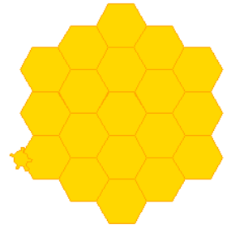Introduction

A beehive is a structure in which honey bees live and raise their young. Natural beehives (or "nests") are made by honey bee colonies, while domesticated honey bees are kept in man-made beehives in a location known as an apiary. Beehives have hexagonal cells in them, packed together. This is called a honeycomb. This honeycomb is said to have a tessellated shape formation.
Task

Beehive
- Your task today is to build a small section of a beehive.
- This drawing will be created using a library in Python called Turtle graphics, in which we will use different angles to fit together with our honeycomb shape!
- You will also learn a little bit about bees and their possible mathematical skills.
Process
Watch the video of tessellations and the the video of honeycombs togheter and discuss what ypu think about bees possible mathematical skills.
Follow the step by step instroctions to make a program that draws a honeycomb pattern.
Your code should:
- Import the Turtle graphic library,
- Control the speed, fill colour and line colour of the turtle,
- Use for loops and subroutines to create the hexagonal shapes,
- Apply previous knowledge of angles to help move the turtle along.
Conclusion
Well done, you have created a honeycomb pattern using hexogons. Next step is to try to change the code so the program makes a tessellation of triangles instead!
Learning Objectives
- You should have confidently been able to import a library into Python,
- You should be confident in using subroutines to create regular shapes.
- You should be comfortable using angles to navigate through regular shapes,
- You should be confident in manipulating the speed and colour within a turtle graphics programme.
- You should have an understadning of tessellations and an idea of why honeycombs are made up by hexagons.





